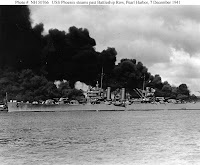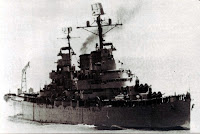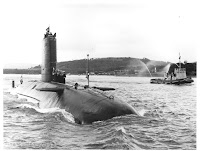Sunday Light Cruiser Blogging: USS Phoenix
 USS Phoenix was the fifth of the Brooklyn class, a group of light cruisers designed in response to the Japanese Mogami class and the restrictions imposed by the London Naval Treaty of 1930. The Treaty, in an effort to limit competition in heavy cruisers, established limits on the number of 8″ gunned cruisers allowed each of the major signatories. The hope, especially on the part of the British, was that naval architects would design new cruisers around the 6″ gun, and scale down the size of the ships appropriately. Unfortunately for the cash strapped Admiralty, this did not occur. Instead, the Japanese built the Mogami class, each armed with 15 6″ guns and as large as a heavy cruiser. The US responded with the Brooklyns, also armed with 15 6″ guns, displacing about 10000 tons, and capable of 33 knots. In US naval doctrine of the time, light cruisers were expected to lay down a wall of fire alongside the main battle line, thus deterring destroyers from closing and launching torpedo attacks. Heavy cruisers would destroy enemy heavy and light cruisers. In practice, there was little functional difference between heavy and light cruisers, as the 6″ guns rapid reload time made up for the extra punch of the 8″ gun. Moreover, pre-war light cruiser doctrine proved impractical, as the wall of fire concept led to extremely inaccurate gunnery. This forced light cruisers to rely on salvo fire instead.
USS Phoenix was the fifth of the Brooklyn class, a group of light cruisers designed in response to the Japanese Mogami class and the restrictions imposed by the London Naval Treaty of 1930. The Treaty, in an effort to limit competition in heavy cruisers, established limits on the number of 8″ gunned cruisers allowed each of the major signatories. The hope, especially on the part of the British, was that naval architects would design new cruisers around the 6″ gun, and scale down the size of the ships appropriately. Unfortunately for the cash strapped Admiralty, this did not occur. Instead, the Japanese built the Mogami class, each armed with 15 6″ guns and as large as a heavy cruiser. The US responded with the Brooklyns, also armed with 15 6″ guns, displacing about 10000 tons, and capable of 33 knots. In US naval doctrine of the time, light cruisers were expected to lay down a wall of fire alongside the main battle line, thus deterring destroyers from closing and launching torpedo attacks. Heavy cruisers would destroy enemy heavy and light cruisers. In practice, there was little functional difference between heavy and light cruisers, as the 6″ guns rapid reload time made up for the extra punch of the 8″ gun. Moreover, pre-war light cruiser doctrine proved impractical, as the wall of fire concept led to extremely inaccurate gunnery. This forced light cruisers to rely on salvo fire instead.
Commissioned in late 1938, USS Phoenix was present at Pearl Harbor, but escaped the attack unharmed. She carried out many missions in the first two years of the war, but did not see combat against Japanese ships or aircraft until June 1944, when she was serially attacked by Japanese bombers and torpedo aircraft. Near misses resulted in light damage. She was part of Admiral Oldendorf’s force at the Battle of Surigao Strait in October 1944, and contributed to the destruction of HIJMS Yamashiro. The rest of her war service was spent mostly in escort, and although accompanying ships experienced several kamikaze attacks, Phoenix escaped damage. After the war, Phoenix was placed in reserve.
 In April 1951, USS Phoenix was sold to Argentina, becoming Diecisiete de Octubre. She was accompanied by her sister Boise, which became Nuevo de Julio. The Brooklyn class cruisers essentially replaced the aging dreadnoughts that the Southern Cone navies had possessed since the 1910s. In addition to the two Argentine ships, Chile picked up two and Brazil one. In 1956 Diecisiete de Octubre was renamed General Belgrano, after an Argentine independence leader. In 1968 General Belgrano was partially modernized, and equipped with two British Sea Cat missile launchers. The Sea Cat, an early anti-aircraft weapon, fired a missile capable of mach .8, slower than most jet fighters and surface-to-surface missiles at the time.
In April 1951, USS Phoenix was sold to Argentina, becoming Diecisiete de Octubre. She was accompanied by her sister Boise, which became Nuevo de Julio. The Brooklyn class cruisers essentially replaced the aging dreadnoughts that the Southern Cone navies had possessed since the 1910s. In addition to the two Argentine ships, Chile picked up two and Brazil one. In 1956 Diecisiete de Octubre was renamed General Belgrano, after an Argentine independence leader. In 1968 General Belgrano was partially modernized, and equipped with two British Sea Cat missile launchers. The Sea Cat, an early anti-aircraft weapon, fired a missile capable of mach .8, slower than most jet fighters and surface-to-surface missiles at the time.
Apart from conducting the initial landings, the Argentine Navy was largely quiet at the  beginning of the Falklands War. On April 26, however, it was decided to dispatch General Belgrano and two escort destroyers on patrol south of the islands. Although the political purpose of this patrol was understandable, its military logic is unclear. General Belgrano did have certain advantages against modern naval vessels. Her 6″ guns would have made very short work of any British ships unfortunate enough to wander within twelve or so miles. General Belgrano’s armor, while considerably lighter than a battleship, might still have been sufficient to provide considerable protection from the surface-to-surface missiles of the day. However, while General Belgrano’s initial probe was in the direction of the British task force, it is extremely unlikely that any British surface ship would have wandered into her patrol area. Having virtually no anti-air or anti-submarine capability, her ability to decisively affect the battle was extremely low. On May 2, General Belgrano and her group began repositioning toward the Argentine mainland, perhaps in preparation for another sortie to be coordinated with the Argentine Air Force.
beginning of the Falklands War. On April 26, however, it was decided to dispatch General Belgrano and two escort destroyers on patrol south of the islands. Although the political purpose of this patrol was understandable, its military logic is unclear. General Belgrano did have certain advantages against modern naval vessels. Her 6″ guns would have made very short work of any British ships unfortunate enough to wander within twelve or so miles. General Belgrano’s armor, while considerably lighter than a battleship, might still have been sufficient to provide considerable protection from the surface-to-surface missiles of the day. However, while General Belgrano’s initial probe was in the direction of the British task force, it is extremely unlikely that any British surface ship would have wandered into her patrol area. Having virtually no anti-air or anti-submarine capability, her ability to decisively affect the battle was extremely low. On May 2, General Belgrano and her group began repositioning toward the Argentine mainland, perhaps in preparation for another sortie to be coordinated with the Argentine Air Force.
 Unfortunately for the Argentines, ARA General Belgrano had been detected by the submarine HMS Conqueror on April 29. Conqueror shadowed the group while Prime Minister Margart Thatcher decided on an appropriate course of action. On May 2, she decided that Conqueror should attack the Argentine cruiser. Conqueror moved into position and fired three conventional, non-homing torpedos at General Belgrano. Two of the torpedos hit. The captains of the accompanying destroyers claimed that, because of the gloom and the electrical failure on the cruiser, they were unaware that General Belgrano had been hit. They moved off, and only noticed the absence of the cruiser several hours later. Inspection after the battle would indicate that one of the destroyers had been hit by a torpedo that failed to explode, indicating, among other things, superb marksmanship on the part of Conqueror. Severely damaged, General Belgrano rolled over and sank about thirty minutes after the attack. 770 of the crew were later rescued, but 323 Argentines died.
Unfortunately for the Argentines, ARA General Belgrano had been detected by the submarine HMS Conqueror on April 29. Conqueror shadowed the group while Prime Minister Margart Thatcher decided on an appropriate course of action. On May 2, she decided that Conqueror should attack the Argentine cruiser. Conqueror moved into position and fired three conventional, non-homing torpedos at General Belgrano. Two of the torpedos hit. The captains of the accompanying destroyers claimed that, because of the gloom and the electrical failure on the cruiser, they were unaware that General Belgrano had been hit. They moved off, and only noticed the absence of the cruiser several hours later. Inspection after the battle would indicate that one of the destroyers had been hit by a torpedo that failed to explode, indicating, among other things, superb marksmanship on the part of Conqueror. Severely damaged, General Belgrano rolled over and sank about thirty minutes after the attack. 770 of the crew were later rescued, but 323 Argentines died.
 There had been some hope for mediation before the attack on General Belgrano, but these hopes sank almost as quickly as the cruiser. Argentines have ascribed belligerant motives to the British, claiming that the ship was outside a previously announced exclusion zone, and that it was moving away from the British task force. However, the exclusion zone was generally understood to have been abrogated, and no principle of war excludes attacks on retreating, as opposed to surrendered, enemy forces. Indeed, since General Belgrano was repositioning rather than retreating, she still represented a potential threat to British forces. Finally, while General Belgrano’s obsolescence limited the threat that she could pose to British forces, there remained some plausible ways in which she could have restricted British operations around the islands. Moreover, the sinking of General Belgrano helped deter the Argentine Navy from further action, greatly facilitating the British war effort.
There had been some hope for mediation before the attack on General Belgrano, but these hopes sank almost as quickly as the cruiser. Argentines have ascribed belligerant motives to the British, claiming that the ship was outside a previously announced exclusion zone, and that it was moving away from the British task force. However, the exclusion zone was generally understood to have been abrogated, and no principle of war excludes attacks on retreating, as opposed to surrendered, enemy forces. Indeed, since General Belgrano was repositioning rather than retreating, she still represented a potential threat to British forces. Finally, while General Belgrano’s obsolescence limited the threat that she could pose to British forces, there remained some plausible ways in which she could have restricted British operations around the islands. Moreover, the sinking of General Belgrano helped deter the Argentine Navy from further action, greatly facilitating the British war effort.


